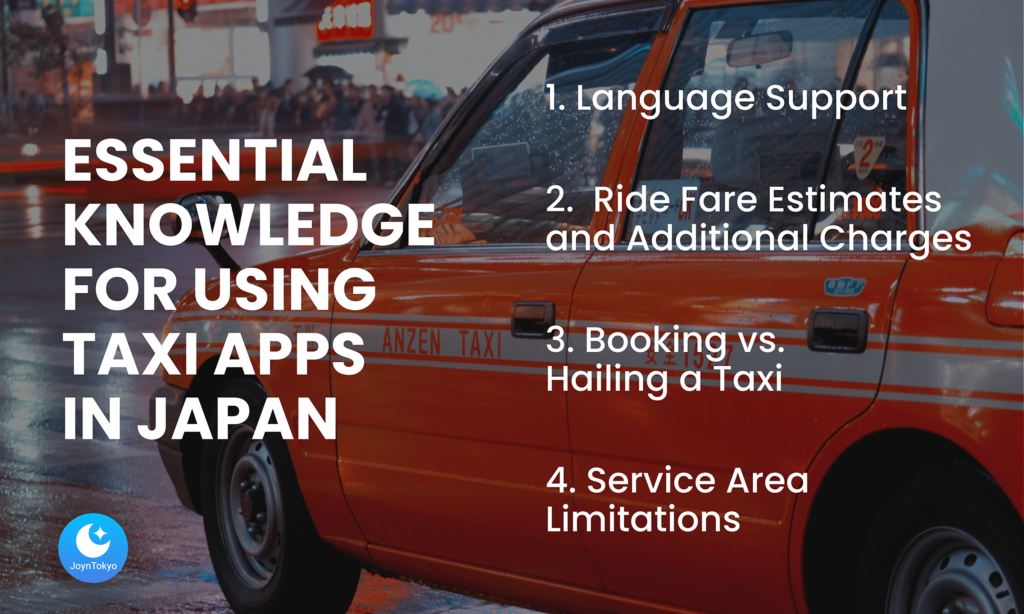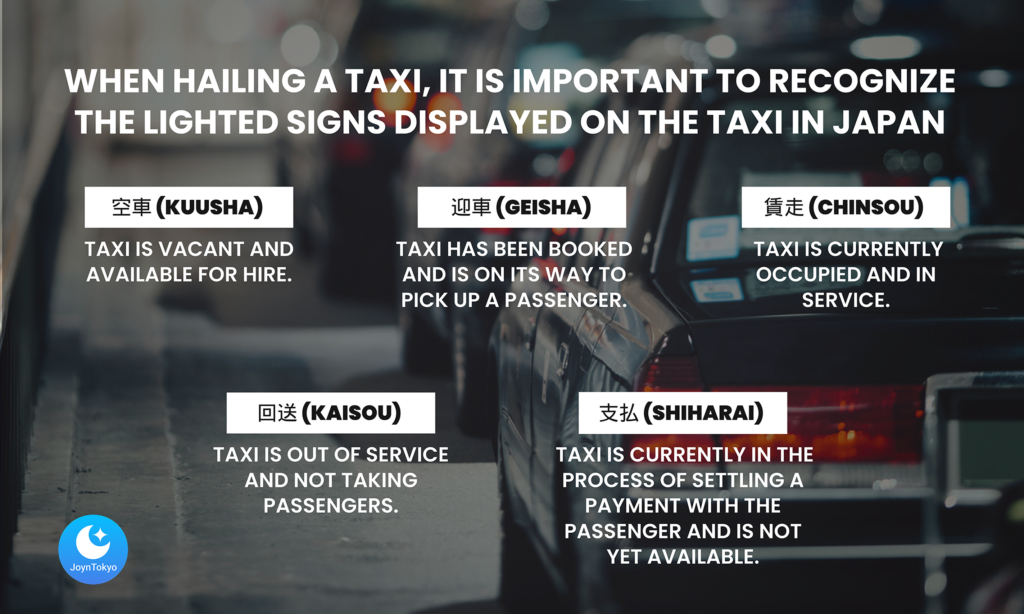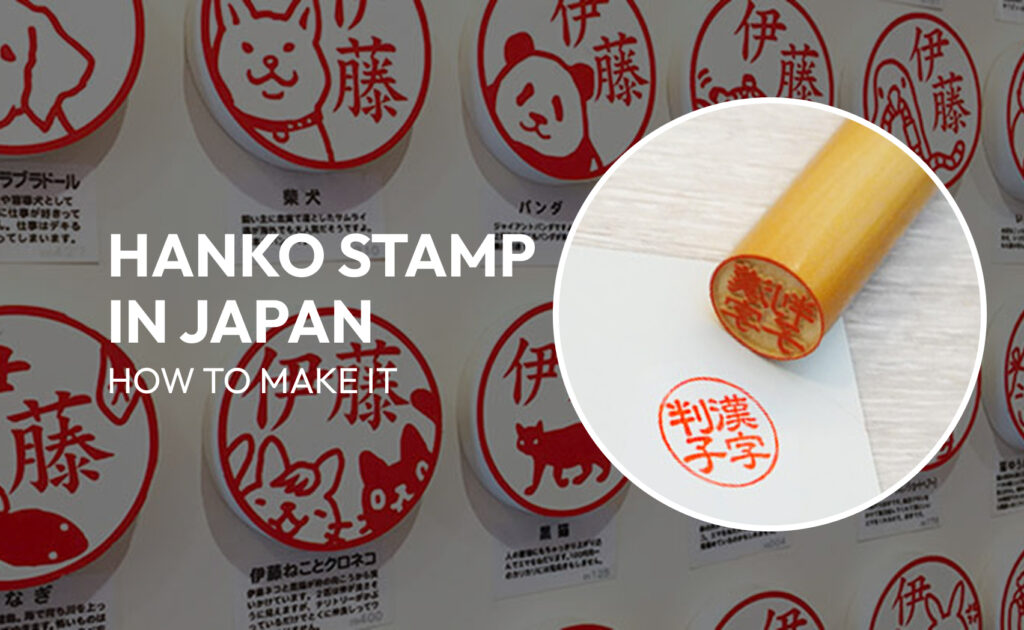Navigating Japan’s transportation system can be challenging for foreigners, and using taxis is no different. While public transportation is typically highly efficient, taxis can be the most convenient option, especially late at night or in areas with limited train or bus services. Fortunately, several taxi apps in Japan make it easier to book a ride, avoiding language barriers and fare confusion. Let’s explore the best taxi apps available, and the need-to-knows for using taxis in Japan effectively.
Recommended Taxi Apps in Japan

There are several taxi apps available in Japan, each offering unique features and coverage areas. Here are some of the most reliable and widely used options.
GO

GO is one of the most popular taxi-hailing apps in Japan, and covers major cities like Tokyo, Osaka, and Kyoto. The app allows users to book a taxi in advance or request an immediate ride. It also provides upfront fare estimates, meaning there will be no surprises at the ride’s end. Additionally, GO allows for multiple payment options, including:
- Credit and debit cards (Visa, MasterCard, JCB, AMEX, Diners Club)
- Cash
- Mobile payment services (PayPay, LINE Pay, Rakuten Pay, Apple Pay, Google Pay)
- IC Cards (Suica, PASMO)
DiDi

First launched in China, DiDi has expanded into the Japanese market, primarily serving urban areas. The app offers multilingual support, making it an excellent choice for expats and visitors whose Japanese level is limited. Users can select cashless payment options and receive estimated fares before confirming a ride. Payment methods include:
- Credit and debit cards (Visa, MasterCard, JCB, AMEX, Diners Club)
- Cash
- Mobile payment services (Apple Pay, Google Pay, PayPay, LINE Pay, WeChat Pay)
- IC Cards (Suica, PASMO)
S.RIDE

S.RIDE is another reliable taxi app, especially in the Tokyo metropolitan area. The app is known for its simple swipe-based booking system and seamless payment integration. S.RIDE supports various payment methods, including:
- Credit and debit cards (Visa, MasterCard, JCB, AMEX, Diners Club)
- Mobile payment services (Apple Pay, Google Pay, PayPay, LINE Pay)
- IC Cards (Suica, PASMO)
Uber Japan

While Uber is widely used globally, its presence in Japan is limited compared to local taxi apps. However, Uber operates in some major cities, including Tokyo, Osaka, and Kyoto. Unlike standard Uber services in other countries, Uber Japan primarily works with licensed taxi companies rather than independent drivers. Payment methods include:
- Credit and debit cards (Visa, MasterCard, JCB, AMEX, Diners Club)
- Cash (in select locations)
- Mobile payment services (Apple Pay, Google Pay, PayPay, LINE Pay)
- IC Cards (Suica, PASMO)
Essential Knowledge for Using Taxi Apps in Japan

Understanding how to use taxi apps in Japan effectively can enhance your experience and prevent common missteps. Here are some key keys to consider.
1. Language Support
Many taxi apps offer English language support, but some features or driver communications may still be in Japanese. If necessary, use translation apps or prepare basic Japanese phrases for taxi rides.
2. Ride Fare Estimates and Additional Charges
Most taxi apps display estimated fares before confirming a ride. However, final fares may vary due to traffic conditions and additional charges, such as nighttime surcharges and highway tolls.
3. Booking vs. Hailing a Taxi

If you are in a busy area, such as a train station or shopping district, availability may vary depending on demand. In Japan, it is also common to hail a taxi by raising your hand while standing near a curb. This method is often effective, especially in busy areas or when taxis are readily available.
When hailing a taxi, it is important to recognize the lighted signs displayed on the taxi:
- 空車 (Kuusha) – This means the taxi is vacant and available for hire.
- 迎車 (Geisha) – This indicates that the taxi has been booked and is on its way to pick up a passenger.
- 賃走 (Chinsou) – This means the taxi is currently occupied and in service.
- 回送 (Kaisou) – This means the taxi is out of service and not taking passengers.
- 支払 (Shiharai) – This means the taxi is currently in the process of settling a payment with the passenger and is not yet available.
4. Service Area Limitations
While taxi apps operate in most major cities, their coverage may be limited in rural or remote areas. Before relying on an app, check its coverage in your location.
Final Thoughts: Choosing the Right Taxi App
Using a taxi app in Japan can significantly simplify transportation, especially for anyone unfamiliar with the country’s taxi system. GO and DiDi are excellent choices for major cities, while Uber offers a familiar interface for international travelers. S.RIDE is ideal for those staying within Tokyo, though users should always check coverage and payment options before selecting an app.
By understanding the available options and essential knowledge for using taxis in Japan, foreign residents and travelers can enjoy a seamless and stress-free taxi experience.







